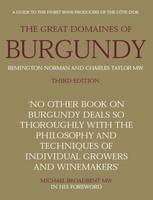The Great Domaines of Burgundy, Remington Norman and Charles Taylor MW
| Title of book: | The Great Domaines of Burgundy |
| Author: | Remington Norman and Charles Taylor MW |
| Publisher: | Kyle Cathie |
| Publication date: | 2010 |
| ISBN | 978 1 85626 812 7 |
| Pages: | 288 |
| Price: | £40 |

The Great Domaines of Burgundy, Remington Norman and Charles Taylor MW
This long-time, must-have reference book for the major properties in Burgundy has been wholly updated. The third edition has drawn on the expertise of Charles Taylor MW, an acknowledged expert on, and merchant of, domaine wines from Burgundy (and elsewhere).
Each village commune in the Côte d’Or, for this is on what the book concentrates, is given an introduction including a map charting the village, premier and grand cru plots. The grand crus, and their acreage, are listed. All this brings to life the small scale of top Burgundy production. Chambolle-Musigny has just 176 hectares (ha) of vines, of which 24 ha are grand cru. Puligny-Montrachet has 229 ha including 21ha of grand cru. Bordeaux’s Château Lafite alone is 100 ha, yet 71 vignerons share the Puligny land, giving an average holding of a microscopic 3.2 ha. Thus the necessary minutiae of detail required to gain a sensible understanding of domaine Burgundy is all in this book.
The reader can build up a picture of broad stylistic differences between communes – Gevrey-Chambertin’s power and muscle, Chambolle-Musigny’s finesse and elegance, or Vosne-Romanée’s silkiness and opulence, though stylistic differences between producers are oft-cited as equally important.
The neat, producer by producer, layout has changed little since the 1996 second edition. The number of producers discussed has grown by fifteen, but this includes thirty-nine new entries, as others have dropped out. Newcomers include Fourrier (Gevrey-Chambertin), Louis Boillot (Chambolle-Musigny), and Michel Niellon (Chassagne-Montrachet).
Given that some domaines appear to have similar names, it is good that at least some of the intricacies of familial lineage can be unravelled by careful reading, although a few diagrammatic extended family trees would have fitted in well here. Marrying into the family of neighbouring vignerons seems far from rare.
In addition to these two elements, about 15% of the book is devoted to issues of making wine in Burgundy, such as soil, climate, the use of oak, organics/biodynamics, as well as the two grape protagonists which sit diametrically opposite each other: adaptable, forgiving chardonnay versus intolerant, slightly OCD pinot noir. These ‘essays’ are rich with examples that illustrate changing practices and fascination for the continued mystery of some aspects of terroir. Vignettes of intimate observations by passionate growers detail the intricacy of Burgundian viticulture. They reveal insights that may both develop and frustrate the reader’s grip of knowledge of this region, but it’s certainly not a book to be missing from the Burgundy lover’s bookcase.



